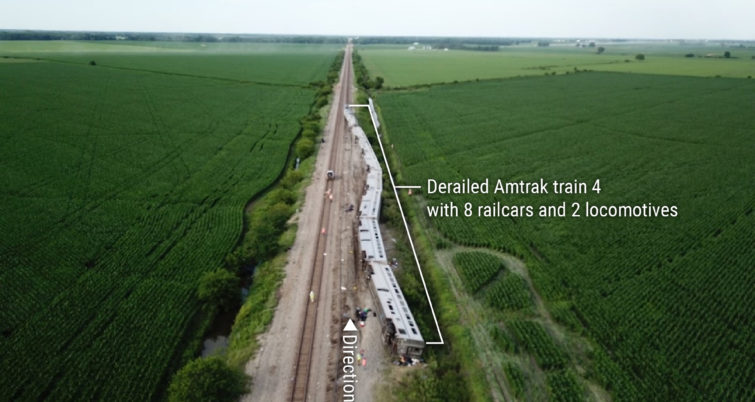Watch: First NTSB report on Amtrak collision with dump truck in June
Written by David C. Lester, Editor-in-Chief
The National Transportation Safety Board (NTSB) has released its first report on the collision between Amtrak's Southwest Chief and a dump truck in rural Missouri.
Ed. note: Although RT&S generally limits derailment coverage to those associated with track problems, this accident occurred at a rail-highway grade crossing, and as you’ll read below, the NTSB will focus on the railroad crossing’s design specifications, which is within the purview of our coverage. DCL
Here is the NTSB’s initial report:
_____________________________________________________________________________________________
What Happened
This is preliminary information, subject to change, and may contain errors. Any errors in this report will be corrected when the final report has been completed.
On June 27, 2022, about 12:42 p.m. local time, eastbound National Railroad Passenger Corporation (Amtrak) train 4 (also known as the Southwest Chief), carrying 270 passengers and 12 crew, derailed in Mendon, Missouri after colliding with a 2007 Kenworth W900B dump truck that was fouling a highway railroad grade crossing. (1) (See image above.) Three train passengers and the truck driver died, and multiple passengers and crew were transported to local hospitals with injuries. Damage was estimated by Amtrak and BNSF Railway (BNSF) to be about $4 million.
Amtrak train 4, traveling from Los Angeles, California, to Chicago, Illinois, consisted of two locomotives and eight railcars. The collision with the fully loaded dump truck occurred at milepost 363.8 on the BNSF Marceline Subdivision near a rural passive highway railroad grade crossing on County Road 113, also known as Porsche Prairie Avenue. The highway railroad grade crossing was equipped with crossbucks, and a stop sign on the right side of Porsche Prairie Avenue as the dump truck driver approached from the south. All locomotives and railcars derailed with seven of the railcars coming to a rest on their sides. The dump truck received heavy damage and came to rest in a ditch northeast of the rail crossing adjacent to the road.
In the vicinity of the accident area, BNSF authorizes train movements with a traffic control system. Train movements are coordinated by a BNSF train dispatcher located at the Dispatch Center in Fort Worth, Texas. Train movements on the Marceline Subdivision are governed by operating rules, special instructions, timetable instructions, and the signal indications of the traffic control system and supplemented with an overlaid positive train control (PTC) system. The maximum allowable speed on this section of track was 90 mph for passenger trains. The PTC system was enabled and operating at the time of the collision. Preliminary review of the data from the leading locomotive’s event recorder showed that train 4 was traveling 89 mph when its emergency brakes were activated. The weather was clear with no precipitation at the time of the accident.
While on scene, National Transportation Safety Board (NTSB) investigators conducted highway railroad grade crossing inspections and highway vehicle inspections, reviewed data from the lead locomotive’s forward-facing image recorder and event recorder, obtained the dump truck’s engine control module, and conducted interviews. NTSB’s investigation is ongoing. Future investigative activity will focus on highway railroad grade crossing design specifications, railcar design, survival factors, and passenger railcar crashworthiness.
Parties to this investigation include the Federal Railroad Administration, Amtrak, BNSF, the International Association of Sheet Metal, Air, Rail and Transportation Workers – Transportation Division, the Brotherhood of Locomotive Engineers and Trainmen, Missouri State Highway Patrol, and Missouri Department of Transportation.
Video NTSB briefings
June 28
June 29
Notes
1 (a) All times in this document are local time unless otherwise noted. (b) Amtrak is a passenger railroad service that provides medium- and long-distance intercity passenger rail service in the contiguous United States and to nine cities in Canada. (c) Fouling refers to being in proximity to a track such that the individual or equipment could be struck by a moving train.
2 Passive highway railroad grade crossings lack train-activated signals or gates to warn of an approaching train. Traffic control devices at passive crossings include advance warning signs, pavement markings, crossbucks, and stop signs.
Read more articles on railroad safety.
For brief news updates and commentary, please follow me on Twitter @davidclesterRTS.





